Do you ever wish you could bring the feel of a tropical paradise into your home? With the tropical interior design style, you can do just that! This style is all about embracing the beauty and serenity of nature, creating a relaxed and inviting atmosphere that will make you feel like you’re on vacation every day. In this article, we will delve into the history of tropical interior design, explore its key elements, and provide tips for incorporating this style into your own home. Get ready to transform your space into a lush, vibrant oasis!

Table of Contents
History of Tropical Interior Design Style
The history of tropical interior design style can be traced back to the colonial era when European countries established colonies in tropical regions like the Caribbean, Africa, and Southeast Asia. The European settlers were captivated by the vibrant colors, rich textures, and exotic materials found in these regions. They began incorporating these elements into their homes, blending their traditional design styles with local influences to create a unique fusion that came to be known as tropical interior design.
Over time, the tropical interior design style has evolved and adapted, drawing inspiration from various cultures and regions across the globe. Today, it is characterized by its emphasis on natural materials, vibrant colors, and lush greenery, all of which work together to create a relaxing and inviting atmosphere reminiscent of a tropical paradise.
Key Elements of Tropical Interior Design Style
To achieve a tropical interior design look, consider incorporating the following key elements:
Natural materials
Tropical design is all about connecting with nature. Use materials such as bamboo, rattan, teak, and woven grasses for furniture, as well as jute or sisal rugs to add texture and warmth.
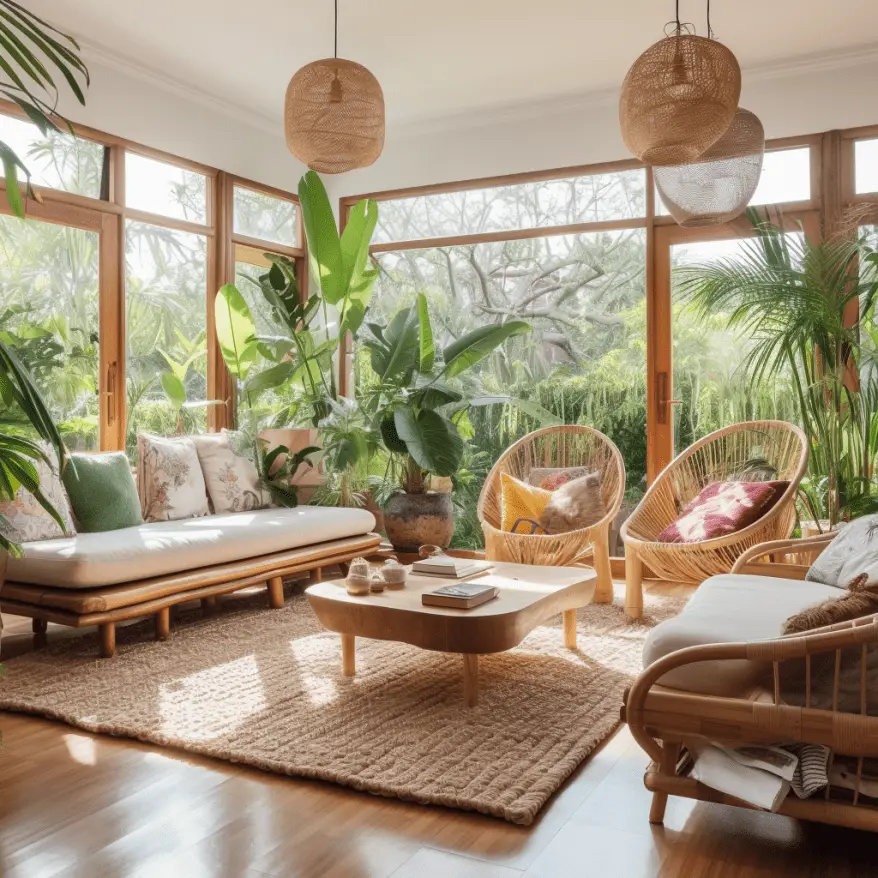
Vibrant colors
Think of the colors found in tropical environments – lush greens, bold blues, sunny yellows, and fiery reds and oranges. Use these colors sparingly as accents to create a sense of energy and life.
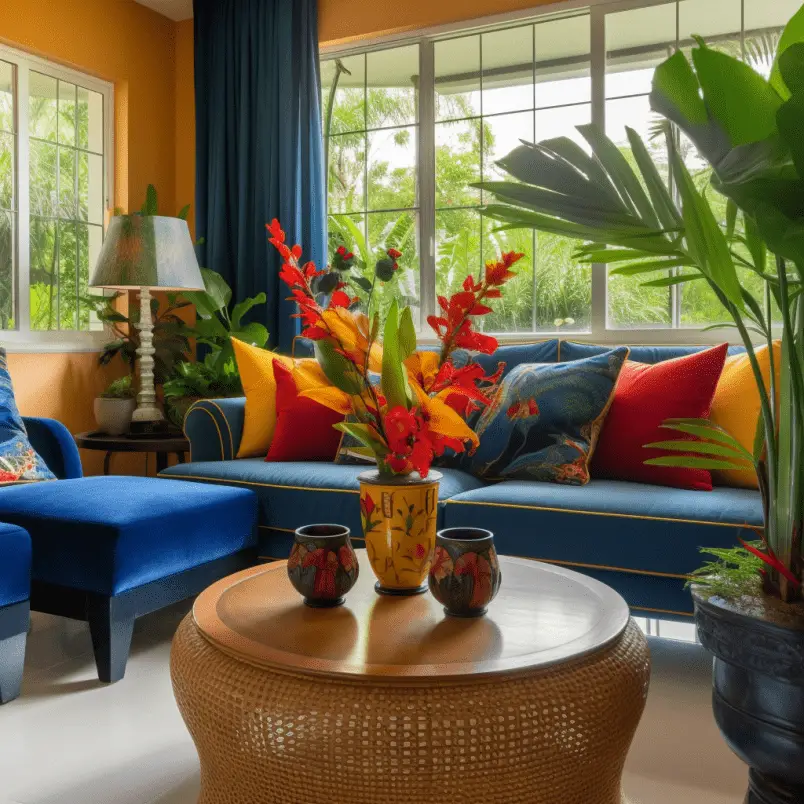
Lush greenery
Plants are a must-have in tropical interiors. They not only purify the air but also bring a sense of life and vibrancy to your space. Opt for large, leafy plants like palm trees, ferns, and monstera to create an indoor jungle vibe.
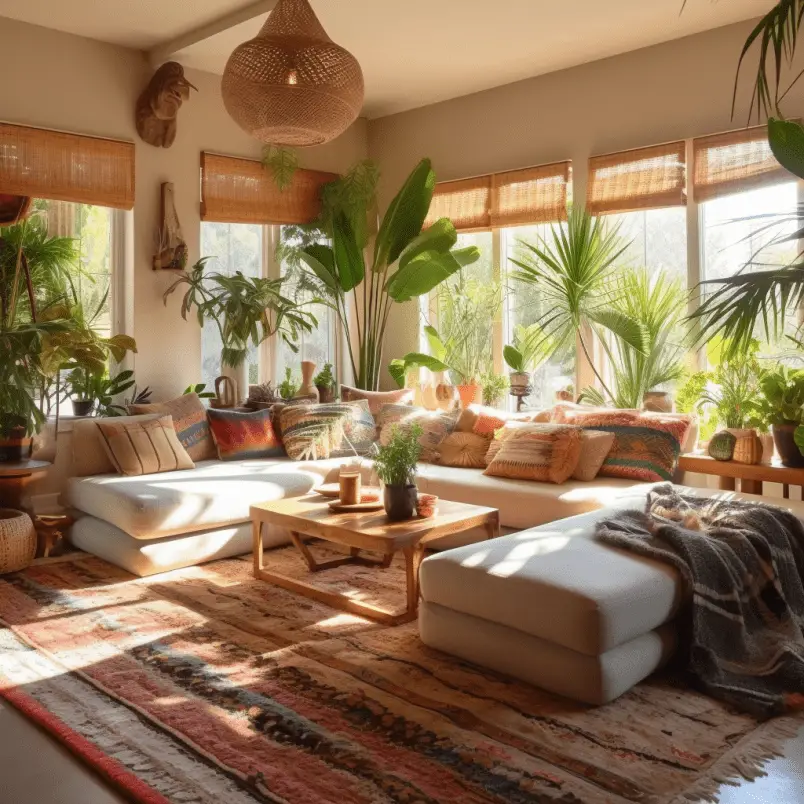
Light and airy fabrics
Keep your window treatments light and breezy to allow for plenty of natural light. Linen and cotton fabrics in light, neutral tones work well for curtains and cushions. You can also incorporate tropical patterns and motifs, such as palm leaves, pineapples, or exotic flowers, to enhance the theme.
Eclectic accents
To create a truly unique tropical interior, mix and match different styles, textures, and patterns. Consider incorporating artwork or accessories inspired by tropical cultures or animals, such as tiki masks, tribal prints, or carved wooden sculptures.
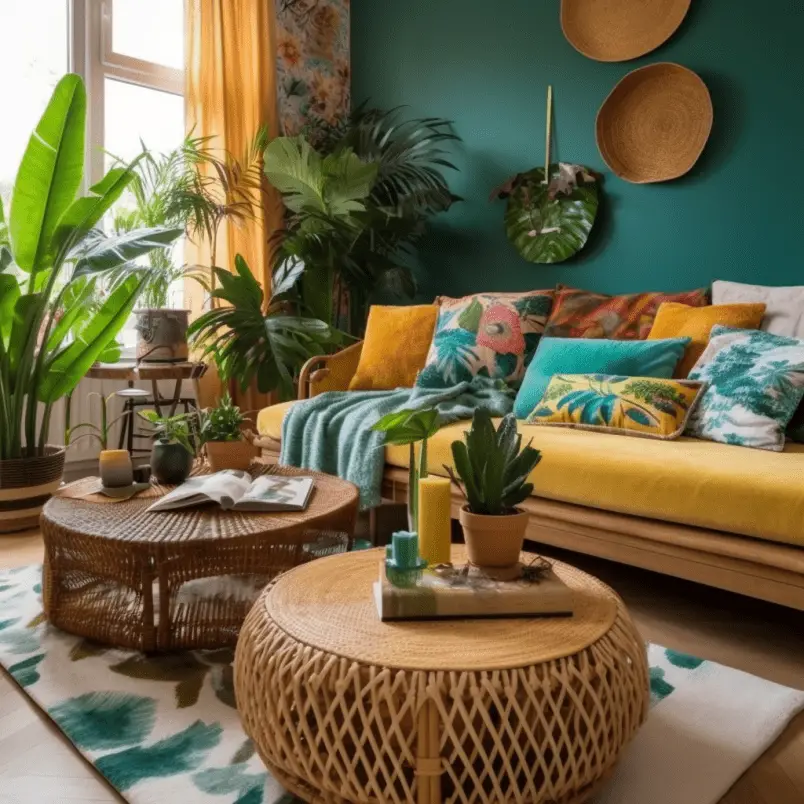
How to Incorporate Tropical Interior Design into Your Home
Incorporating tropical interior design into your home is all about finding the right balance between vibrant colors, natural materials, and lush greenery. Here are some tips to get you started:
- Start by choosing a neutral base color for your walls, such as white, beige, or soft gray. This will provide a blank canvas for you to build upon with vibrant accents and lush greenery.
- Incorporate natural materials, such as rattan or bamboo furniture, and jute or sisal rugs. This will help create a sense of warmth and connection to nature.
- Add pops of color with cushions, artwork, and accessories. Look for bold, tropical-inspired patterns and prints to bring your space to life.
- Bring the outdoors in by adding plenty of plants. Large, leafy plants like palms, ferns, and monsteras will help create a lush, tropical atmosphere
- Don’t be afraid to mix and match different styles, textures, and patterns. Embrace an eclectic approach by combining traditional and modern elements, tribal prints, and unique accessories that reflect your personality and taste.
Tropical Interior Design in Different Rooms
You can easily incorporate tropical interior design elements into various rooms in your home:
Living room
Opt for a large, comfortable rattan or bamboo sofa, paired with colorful cushions in tropical patterns. Add a jute or sisal rug and plenty of plants to create a cozy, inviting atmosphere.
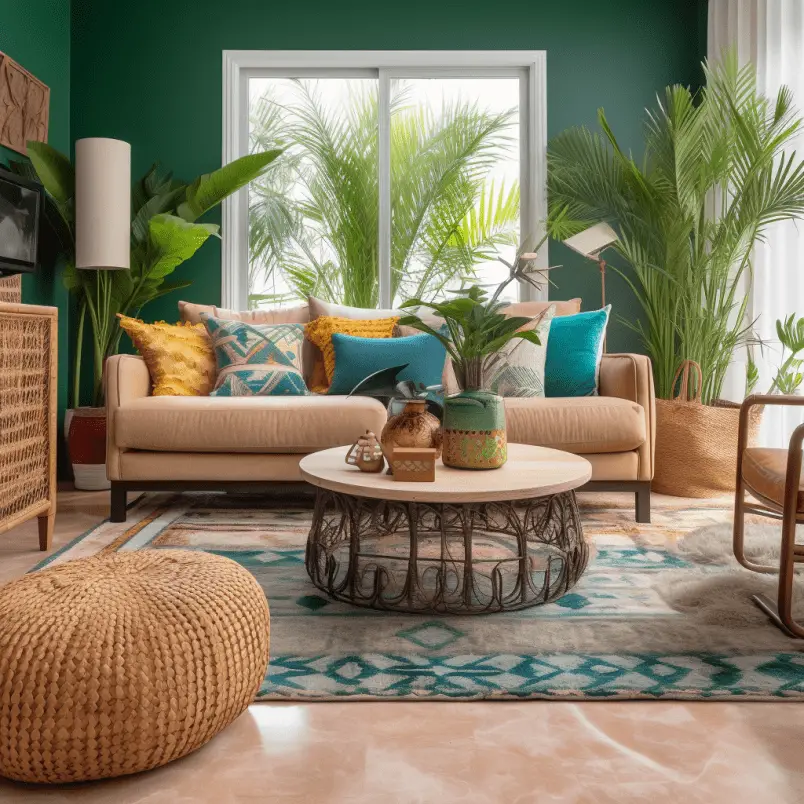
Bedroom
Choose a bed frame made from natural materials like teak or bamboo, and dress your bed in light, airy linens with tropical-inspired prints. Add some large, leafy plants to make your bedroom feel like a tranquil retreat.
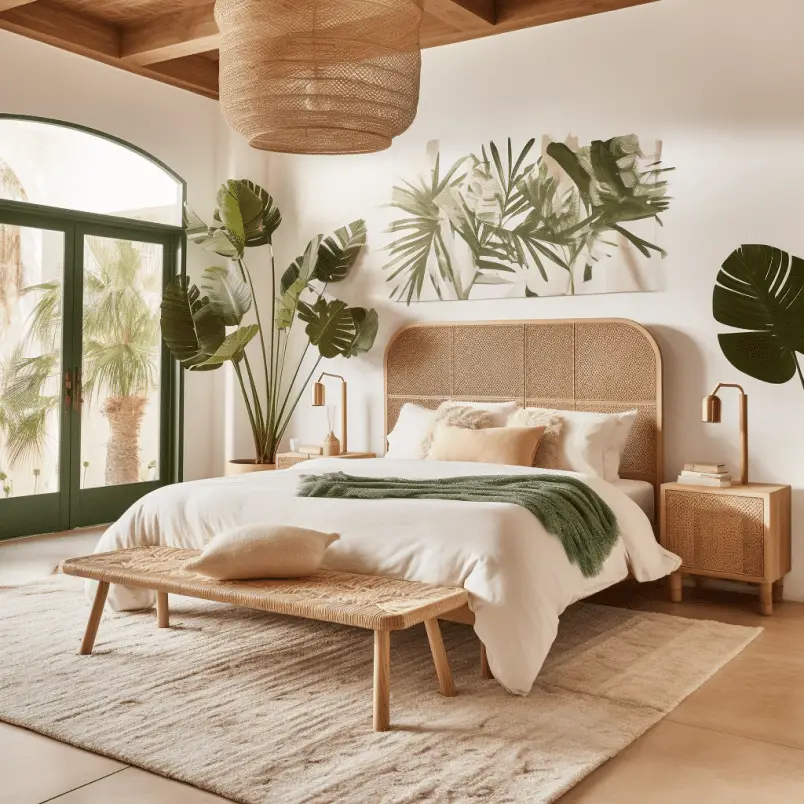
Kitchen
Incorporate vibrant, tropical-inspired colors through backsplash tiles, colorful dishware, or patterned kitchen textiles. Use natural materials like bamboo for your countertops, shelving, or barstools.
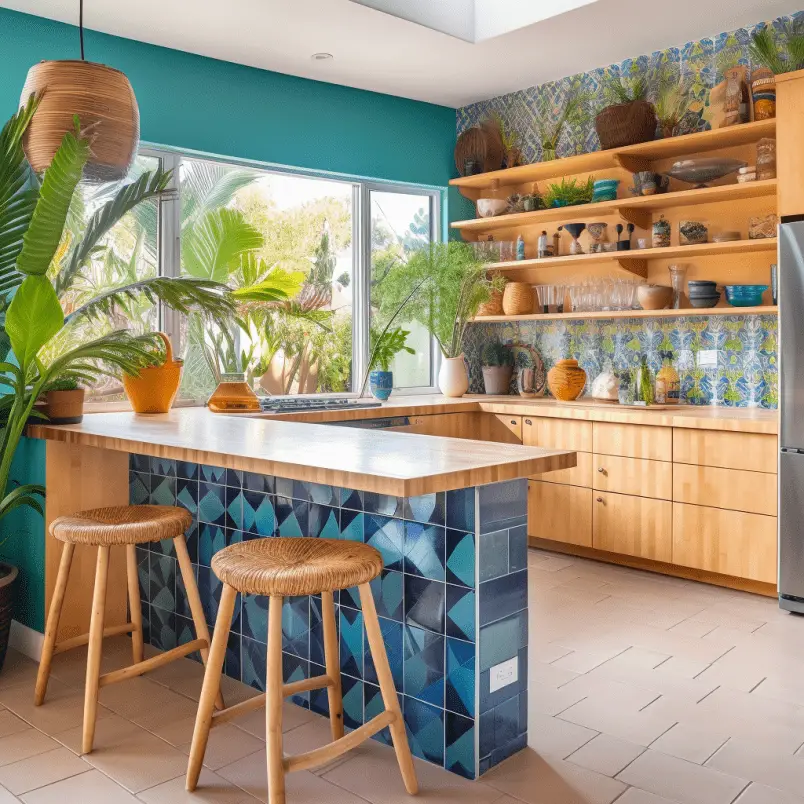
Bathroom
Create a spa-like atmosphere with a teak or bamboo bath mat, tropical plants, and light, airy shower curtains in tropical prints or patterns.
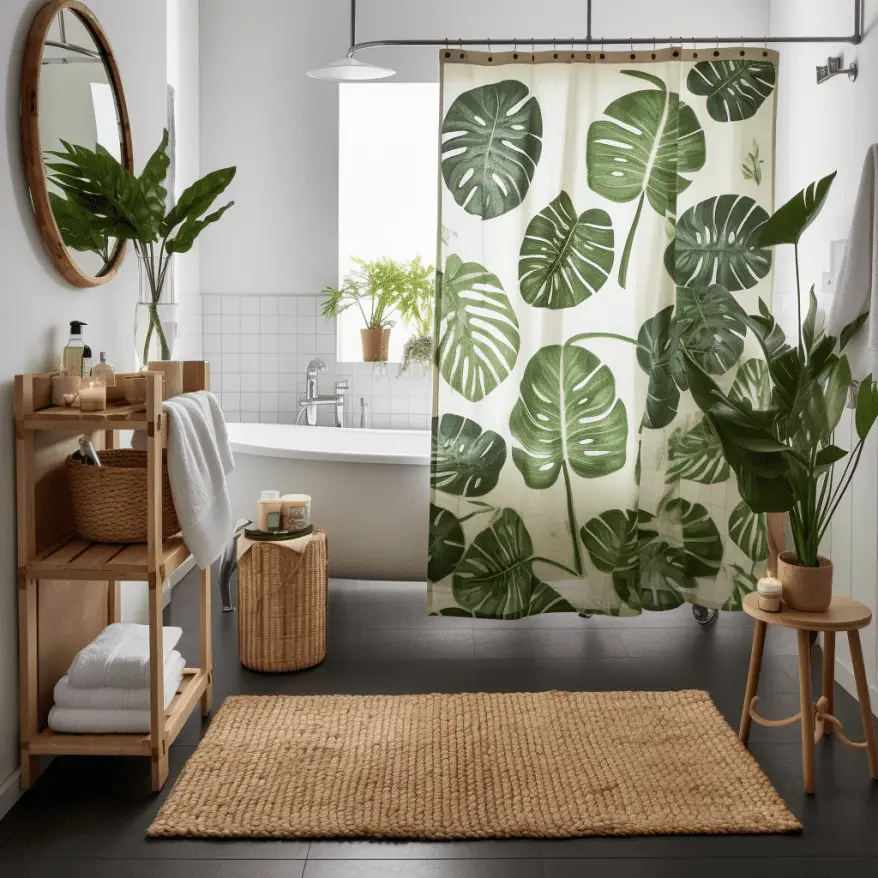
Pros and Cons of Tropical Interior Design
Pros:
- Creates a relaxing, inviting atmosphere that feels like a vacation retreat.
- Emphasizes the use of natural materials, making it an eco-friendly design choice.
- Allows for a creative and eclectic approach, enabling you to express your personality and taste.
Cons:
- Some elements, such as large plants or certain natural materials, may require extra maintenance and care.
- Bold colors and patterns might not appeal to everyone’s taste or may feel overwhelming if not balanced properly.
- The tropical interior design style may not suit every type of architecture or climate, and may feel out of place in certain settings.
Conclusion
Tropical interior design is a vibrant and inviting style that can help you create a relaxing, nature-inspired atmosphere in your home. By incorporating natural materials, bold colors, lush greenery, and eclectic accents, you can transform your space into a lush paradise reminiscent of a tropical getaway. Keep in mind the balance between these elements to achieve a harmonious and inviting look. So, why not bring a touch of the tropics into your home and create a haven you’ll love to relax in?
FAQ
Is tropical interior design only suitable for homes in tropical climates?
No, tropical interior design can be adapted for any climate. The key is to incorporate elements that evoke the feel of a tropical paradise, such as natural materials, vibrant colors, and lush greenery.
Can I mix tropical interior design with other design styles?
How can I incorporate tropical design on a budget?
Start by focusing on small, impactful changes, such as adding colorful cushions, plants, and tropical-inspired accessories. You can also repurpose or upcycle existing furniture with paint or by adding natural materials like rattan or bamboo accents.
What types of plants work best for tropical interior design?
Large, leafy plants like palms, ferns, and monsteras are ideal for creating a lush, tropical atmosphere. Other suitable options include philodendrons, rubber plants, and fiddle-leaf figs. Be sure to consider the light and humidity requirements of the plants you choose to ensure they thrive in your space.
How can I prevent my tropical interior design from looking too busy or cluttered?
The key is to strike a balance between vibrant colors, natural materials, and greenery. Start with a neutral base color for your walls and build from there. Be selective with your use of bold colors and patterns, using them as accents rather than dominating the space. Additionally, consider the scale and proportion of your furniture and accessories to ensure they complement each other without overwhelming the room.

